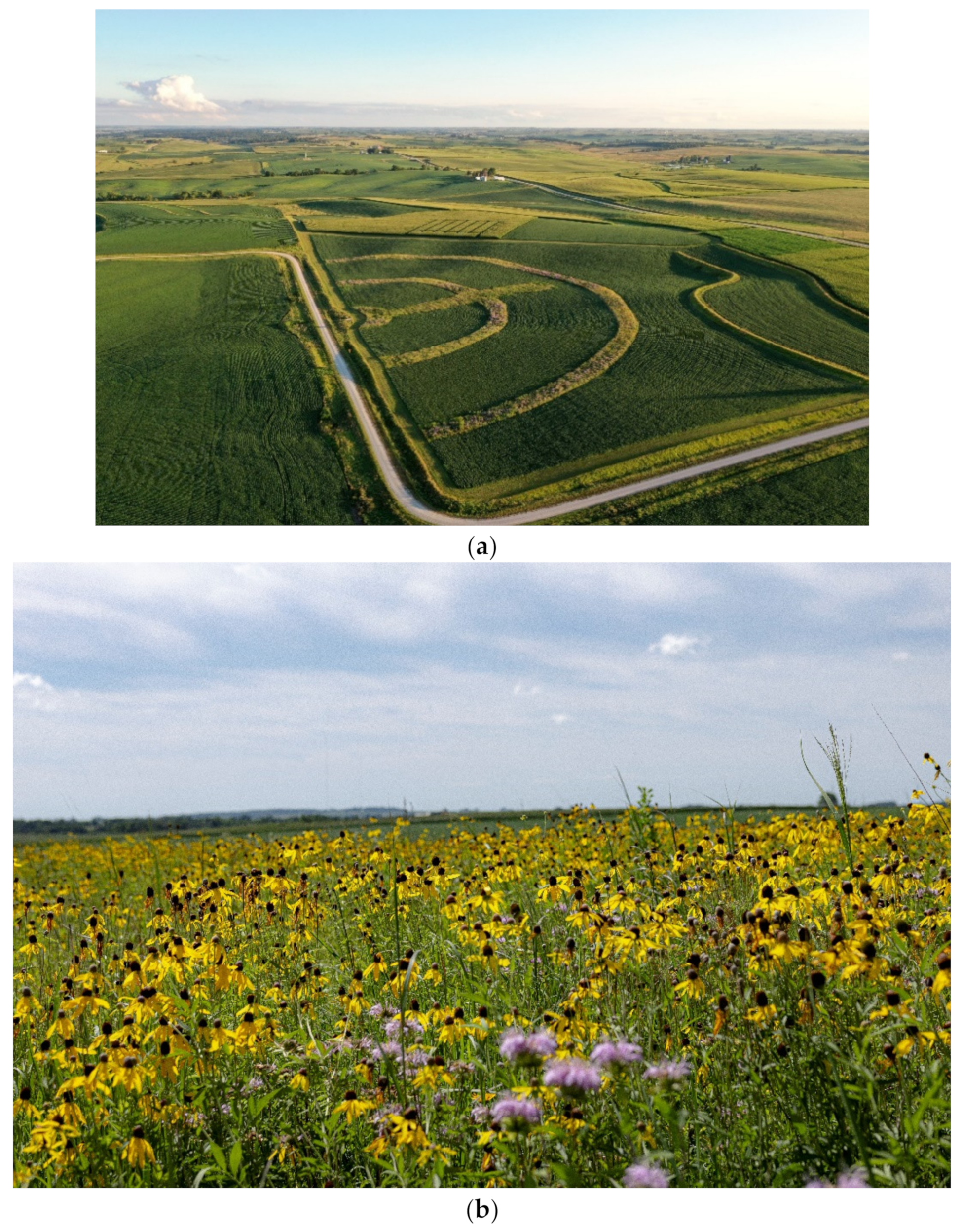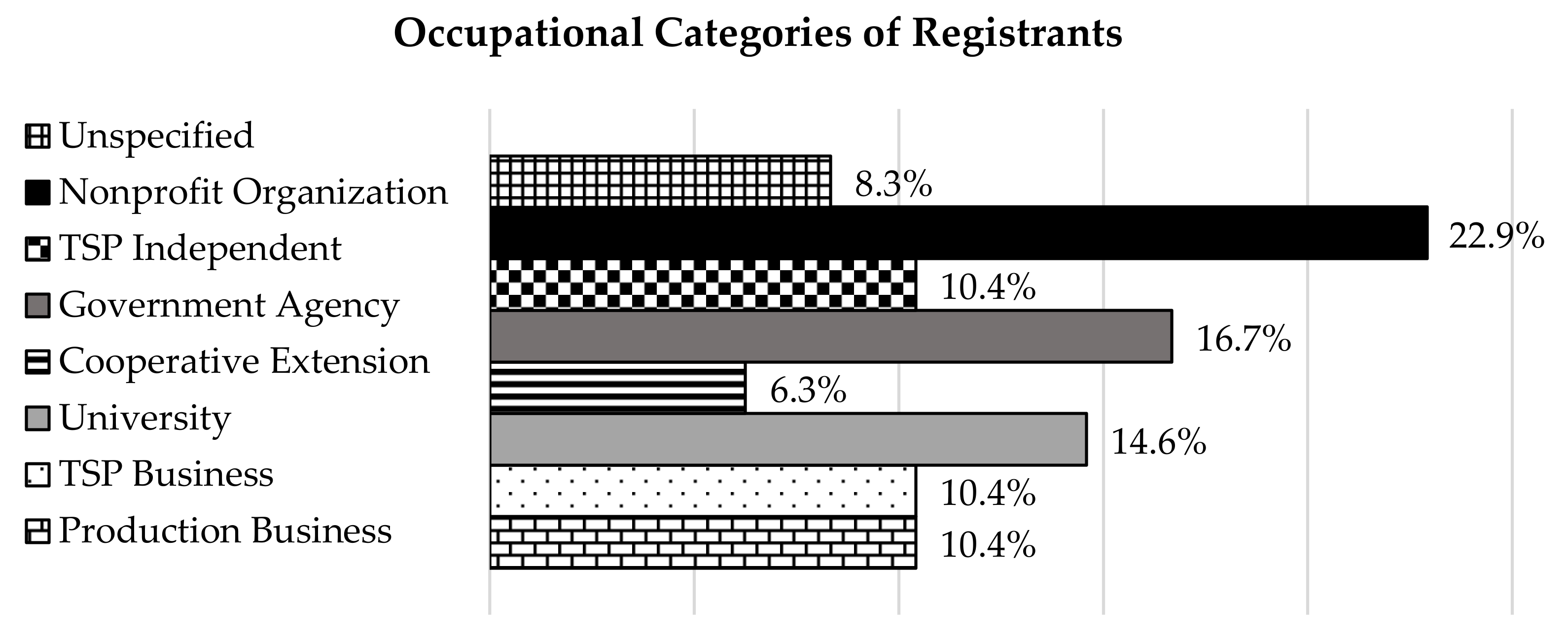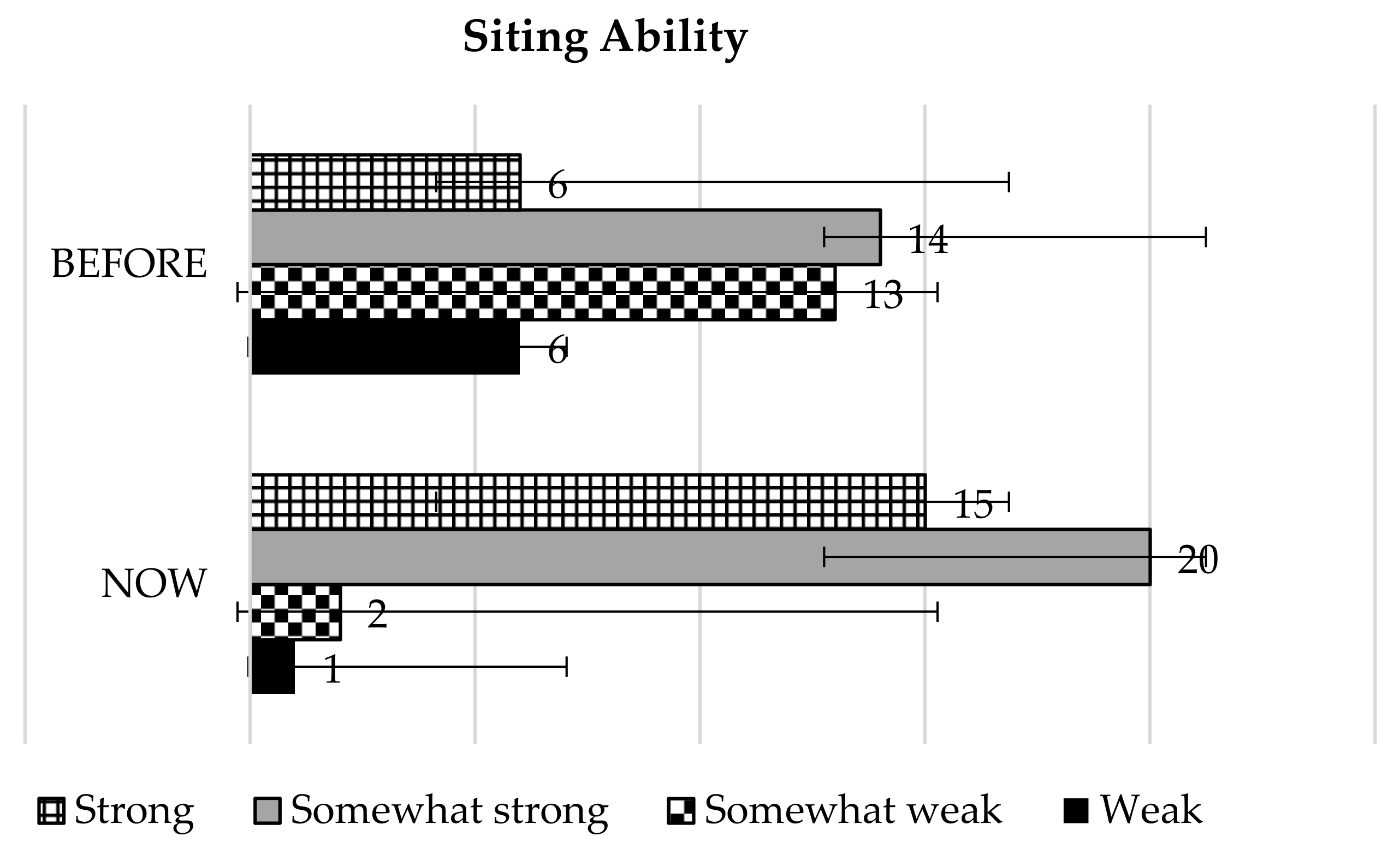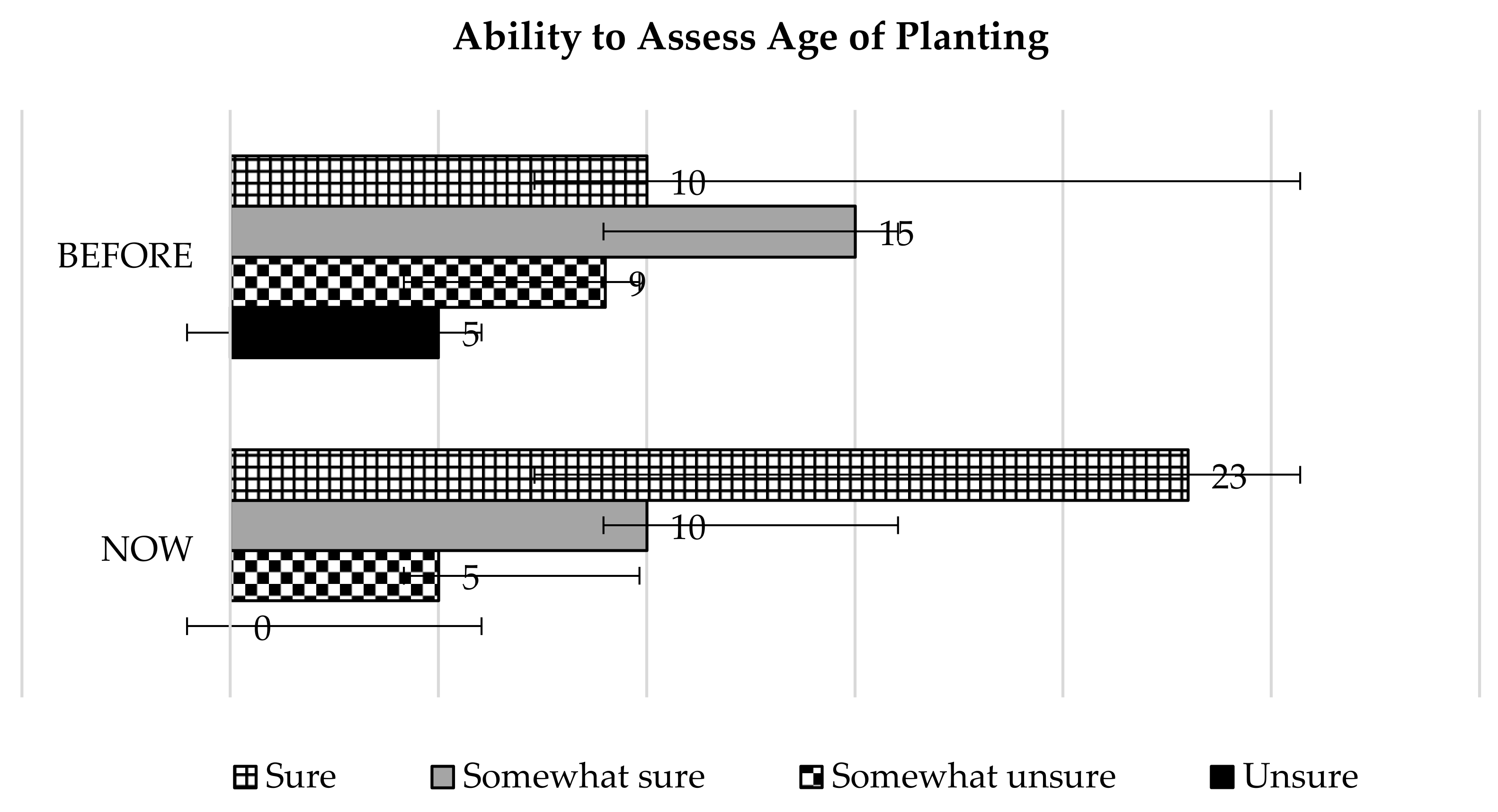Program Evaluation of a Workshop on Prairie Strips for Farm Advisors: Framing the Co-Occurring Outcomes of Low Knowledge Acquisition and High Confidence
Abstract
1. Introduction
1.1. Policies and Practices
1.2. Background
1.3. Communication and Educational Programming
1.4. Farm Advisors
1.5. Identity and Emotional Aspects
1.6. Background of the Study
- Farm advisors will be reminded of the broader issues related to farm-related environmental impacts of row crop agriculture and the warrant for conservation in Midwest agriculture;
- Farm advisors will learn specific knowledge related to prairie strip performance in areas of environmental impacts;
- Farm advisors will be introduced to research on crop-prairie strip interactions;
- Farm advisors will learn to recognize prairie plants, combinations of plants, and age of prairie strips;
- Farm advisors will calculate economic and financial costs of prairie strips;
- Farm advisors will work as a team to site prairie strips using case studies and maps;
- Farm advisors will problem solve with staff and each other about approaches to discussing prairie strips with farmers and landowners; and,
- Farm advisors will share resources for seeds, seed calculators, and county resources.
2. Education and Evaluation
Program Evaluation Frameworks
3. Materials and Methods
3.1. Program Administration
3.2. Evaluation
3.3. End-of-Session Survey
3.4. Research Assurances
4. Results
4.1. Online Survey
4.2. Pre-Posttest
4.3. Retrospective Self-Report
5. Discussion
5.1. Findings and Comparative Evaluations
5.2. Program Planning and Evaluation
6. Conclusions
Author Contributions
Funding
Institutional Review Board Statement
Informed Consent Statement
Data Availability Statement
Acknowledgments
Conflicts of Interest
References
- Jones, C.S.; Schilling, K.E.; Simpson, I.M.; Wolter, C.F. Iowa stream nitrate, discharge and precipitation: 30-year perspective. Environ. Mgmt 2018, 62, 709–720. [Google Scholar] [CrossRef] [PubMed]
- Schulte, L.A.; Niemi, J.; Helmers, M.J.; Liebman, M.; Arbuckle, J.G.; James, G.E.; James, D.E.; Kolka, R.K.; O’Neal, M.E.; Tyndall, J.C.; et al. Prairie strips improve biodiversity and the delivery of multiple ecosystem services from corn–soybean croplands. PNAS 2017, 114, 11247–11252. [Google Scholar] [CrossRef] [PubMed]
- Potts, S.G.; Biesmeijer, J.C.; Kremen, C.; Neumann, P.; Schweiger, O.; Kunin, W.E. Global pollinator declines: Trends, impacts and drivers. Trends Ecol. Evol. 2010, 25, 345–353. [Google Scholar] [CrossRef] [PubMed]
- Rosenberg, K.V.; Dokter, A.M.; Blancher, P.J.; Sauer, J.R.; Smith, A.C.; Smith, P.A.; Stanton, J.C.; Panjabi, A.; Helft, L.; Parr, M.; et al. Decline of the North American avifauna. Science 2019, 366, 120–124. [Google Scholar] [CrossRef]
- Obrycki, J.F.; Karlan, D.L. Optimizing Iowa land use: Past perspectives for current questions. J. Soil Water Conserv. 2018, 73, 693–704. [Google Scholar] [CrossRef]
- Iowa Department of Agriculture and Land Stewardship (IDALS); Iowa Department of Natural Resources (IDNR); Iowa State University, College of Agriculture and Life Sciences (ISU CALS). Updated ed; Iowa Nutrient Reduction Strategy: A Science and Technology-Based Framework to Assess and Reduce Nutrients to Iowa Waters and the Gulf of Mexico 2017. Available online: http://www.nutrientstrategy.iastate.edu/sites/default/files/documents/2017%20INRS%20Complete_Revised%202017_12_11.pdf (accessed on 15 December 2017).
- Prokopy, L.S.; Floress, K.; Arbuckle, J.G.; Church, S.P.; Eanes, F.R.; Gao, Y.; Gramig, B.M.; Ranjan, P.; Singh, A.S. Adoption of agricultural conservation practices in the United States: Evidence from 35 years of quantitative literature. J. Soil Water Conserv. 2019, 74, 520–534. [Google Scholar] [CrossRef]
- Franz, N.K.; Townson, L. The nature of complex organizations: The case of cooperative extension. New Direct. Eval. 2008, 120, 5–14. [Google Scholar] [CrossRef]
- Engler, A.P.; Poortvliet, M.; Klerkx, L. Toward understanding conservation behavior in agriculture as a dynamic and mutually responsive process between individuals and the social system. J. Soil Water Cons. 2019, 74, 74A–80A. [Google Scholar] [CrossRef]
- Lu, J.; Ranjan, P.; Floress, K.; Arbuckle, J.G.; Church, S.P.; Eanes, F.R.; Gao, Y.; Gramig, B.M.; Singh, A.S.; Prokopy, L.S. A meta-analysis of agricultural conservation intentions, behaviors, and practices: Insights from 35 years of quantitative literature in the United States. J. Environ. Mgmt. 2022, 323, 116240. [Google Scholar] [CrossRef]
- Nettle, R.; Crawford; Brightling, P. How private-sector farm advisors change their practices: An Australian case study. J. Rural Stud. 2018, 58, 20–27. [Google Scholar] [CrossRef]
- Eanes, F.R.; Singh, A.S.; Bulla, B.R.; Ranjan, P.; Fales, M.; Wickerham, B.; Patrick, J.; Doran, P.J.; Prokopy, L.S. Crop advisers as conservation intermediaries: Perceptions and policy implications for relying on nontraditional partners to increase U.S. farmers’ adoption of soil and water conservation practices. Land Use Policy 2019, 81, 360–370. [Google Scholar] [CrossRef]
- USDA Natural Resources Conservation Service. Planning and Applying Prairie Strips; Agronomy Technical Note No. 21; USDA National Resources Conservation Services: Washington, DC, USA, 2021.
- Iowa State University. Science-Based Trials of Rowcrops Integrated with Prairie Strips. 2022. Available online: https://www.nrem.iastate.edu/research/STRIPS/ (accessed on 1 October 2022).
- Helmers, M.J.; Zhou, X.; Asbjornsen, H.; Kolka, R.; Tomer, M.D.; Cruse, R.M. Sediment removal by prairie filter strips in row-cropped ephemeral watersheds. J. Environ. Quality. 2012, 41, 1531–1539. [Google Scholar] [CrossRef] [PubMed]
- Zhou, X.; Helmers, M.J.; Asbjornsen, H.; Kolka, R.; Tomer, M.D.; Cruse, R.M. Nutrient removal by prairie filter strips in agricultural landscapes. J. Soil Water Conserv. 2014, 69, 54–64. [Google Scholar] [CrossRef]
- Craig, A.J.; Rehmann, C.R.; Alt, L.M.; Schulte, L.A.; Soupir, M.L. Prairie strips reduce fecal indicator bacteria concentrations in simulated runoff. J. Amer. Water Res. Assn. 2022. [Google Scholar] [CrossRef]
- Schulte, L.A.; MacDonald, A.L.; Niemi, J.B.; Helmers, M.J. Prairie strips as a mechanism to promote land sharing by birds in industrial agricultural landscapes. Agric. Ecosys. Environ. 2016, 220, 55–63. [Google Scholar] [CrossRef]
- Kordbacheh, F.; Liebman, M.; Harris, M. Strips of prairie vegetation placed within row crops can sustain native bee communities. PLoS ONE 2020, 15, e0240354. [Google Scholar] [CrossRef]
- Meissen, J.C.; Glidden, A.J.; Mark, E.; Sherrard, M.E.; Elgersma, K.J.; Jackson, L.L. Seed mix design and first year management influence multifunctionality and cost-effectiveness in prairie reconstruction. Restor. Ecol. 2020, 28, 807–816. [Google Scholar] [CrossRef]
- Glidden, A.J.; Sherrard, M.E.; Meissen, J.C.; Myers, M.C.; Elgersma, K.J.; Jackson, L.L. Planting time, first-year mowing, and seed mix design influence ecological outcomes in agroecosystem revegetation projects. Restor. Ecol. 2022, 13818. [Google Scholar] [CrossRef]
- Rogers, E.M. Diffusion of Innovations, 5th ed.; Free Press of Glencoe: New York, NY, USA, 2003. [Google Scholar]
- Klerkx, L.; Jansen, J. Building knowledge systems for sustainable agriculture: Supporting private advisors to adequately address sustainable farm management in regular service contacts. Intl. J. Agric. Sust. 2010, 8, 148–163. [Google Scholar] [CrossRef]
- Leeuwis, C.; Aarts, N. Rethinking communication in innovation processes: Creating space for change in complex systems. J. Agric. Educ. Exten. 2011, 17, 21–36. [Google Scholar] [CrossRef]
- Arbuckle, J.G., Jr. 2014 Summary report: Iowa Farm and Rural Life Poll; PM 3075; Iowa State University Extension and Outreach: Ames, IA, USA, 2015. [Google Scholar]
- Dockès, A.; Chauvat, S.; Correa, S.; Turlot, A.; Nettle, R. Advice and advisory roles about work on farms: A review. Agron. Sus. Devel. 2019, 39, 2. [Google Scholar] [CrossRef]
- Morris, C.; Arbuckle, J.G.; DeLong, C.; Lindahl, C. Conservation Practitioner Poll 2021; Summary Report; Soil and Water Conservation Society: Ankeny, IA, USA, 2021; Available online: https://www.swcs.org/static/media/cms/Conservation_Practitioner_Poll_2021_58F72FBA81040.pdf (accessed on 15 October 2021).
- Patton, M.Q. Developmental evaluation. J. Eval. Pract. 1994, 15, 311–319. [Google Scholar] [CrossRef]
- Daffron, S.R.; Caffarella, R.S. Planning Programs for Adult Learners: A Practical Guide, 4th ed.; Sage Publications: Thousand Oaks, CA, USA, 2021. [Google Scholar]
- Anderson, L.W.; Krathwohl, D.R. A Taxonomy for Learning, Teaching, and Assessing: A revision of Bloom’s Taxonomy of Educational Objectives; Longman: New York, NY, USA, 2001. [Google Scholar]
- Mangan, J.; Mangan, M.S. A comparison of two IPM training strategies in China: The importance of concepts of the rice ecosystem for sustainable insect pest management. Agric. Hum. Values 1998, 15, 209–221. [Google Scholar] [CrossRef]
- Bandura, A. Self-efficacy: Toward a unifying theory of behavioral change. Psych. Rev. 1977, 84, 191–215. [Google Scholar] [CrossRef]
- Bandura, A. Exercise of human agency through collective efficacy. Curr. Dir. Psych. Sci. 2000, 9, 75–78. [Google Scholar] [CrossRef]
- Goddard, R.D.; Hoy, W.K.; Woolfolk Hoy, A. Collective efficacy beliefs: Theoretical developments, empirical evidence, and future directions. Educ. Res. 2004, 33, 3–13. Available online: https://www.jstor.org/stable/3700071 (accessed on 1 June 2022). [CrossRef]
- Drape, T.A.; Lopez, M.; Radford, D. Teacher efficacy and professional development needs of mid-career agriculture educators integrating the Next Generation Science Standards and other content areas. Career Tech Educ. Res. 2016, 41, 33. [Google Scholar] [CrossRef]
- Lam, C.Y.; Shulha, L.M. Insights on using developmental evaluation for innovating: A case study on the cocreation of an innovative program. Amer. J. Eval. 2015, 36, 58–374. [Google Scholar] [CrossRef]
- Honadle, B.W.; Zapata, M.A.; Auffrey, C.; vom Hofe, R.; Johanna Looye, J. Developmental evaluation and the ‘Stronger Economies Together’ initiative in the United States. Eval. Program Plan. 2014, 43, 64–72. [Google Scholar] [CrossRef]
- Mitchell, A. Second-Order Learning in Developmental Evaluation: New Methods for Complex Conditions Evaluation; Springer Nature Switzerland Palgrave MacMillan: Berlin/Heidelberg, Germany, 2019. [Google Scholar] [CrossRef]
- Carberry, P.S.; Hochman, Z.; McCown, R.L.; Dalgliesh, N.P.; Foale, M.A.; Poulton, P.L.; Hargreaves, J.N.G.; Hargreaves, D.M.G.S.; Cawthray, S.; Hillcoat, N.M.J.; et al. The FARMSCAPE approach to decision support: Farmers’, advisers’, researchers’ monitoring, simulation, communication and performance evaluation. Agric. Syst. 2002, 74, 141–177. [Google Scholar] [CrossRef]
- Robinson, S.B.; Leonard, K.F. Designing Quality Survey Questions; Sage Publications: Thousand Oaks, CA, USA, 2019. [Google Scholar]
- Lam, T.C.M.; Bengo, P. A comparison of three retrospective self-reporting methods of measuring change in instructional practice. Amer. J. Eval. 2003, 24, 65–80. [Google Scholar] [CrossRef]
- Artinger, F.M.; Gigerenzer, G.; Jacobs, P. Satisficing: Integrating two traditions. J. Econ. Lit. 2022, 60, 598–635. [Google Scholar] [CrossRef]
- Swackhamer, E.; Kiernan, N.E. A multipurpose evaluation strategy for master gardener training programs. J. Extension. 2005, 45, 5. Available online: https://tigerprints.clemson.edu/joe/vol43/iss6/5 (accessed on 5 May 2021).
- Mir, D.F.; Finkelstein, Y.; Tulipano, G.D. Impact of integrated pest management (IPM) training on reducing pesticide exposure in Illinois childcare centers. NeuroTox 2010, 31, 621–626. [Google Scholar] [CrossRef] [PubMed]
- Khanal, B.; Schoengold, K.; Mieno, T.; Schulte Moore, L. Impact of policy design on willingness to pay for ecosystem services from prairie strips. J. Agric. Appl. Econ. 2022, 1, 352–369. [Google Scholar] [CrossRef]
- Brandes, E.; McNunn, G.S.; Schulte, L.A.; Bonner, I.J.; Muth, D.J.; Babcock, B.A.; Sharma, E.A.; Heaton, E. Subfield profitability analysis reveals an economic case for cropland diversification. Environ. Res. Lett. 2016, 11, 14009. [Google Scholar] [CrossRef]
- Whitehair, R.; Grudens-Schuck, N. Prairie Strips Consultant Educational Needs Assessment: 2017 Survey; Technical Report; Iowa State University, Department of Agricultural Education and Studies: Ames, IA, USA, 2017; Available online: https://www.nrem.iastate.edu/research/STRIPS/files/publication/prairiestripswsdevneedsassessjune2017_rev5_2_18.pdf (accessed on 5 May 2021).
- Agholor, A.; Issac, S. A review of extension self-efficacy: Bases, features, goal realisation, and implications for extension. S. Afr. J. Ag. Ext. 2019, 47, 140–149. [Google Scholar] [CrossRef]
- Tallgrass Prairie Center. Tallgrass Prairie Center 2020-2021 Highlights; University of Northern Iowa, Tallgrass Prairie Center: Cedar Fall, IA, USA, 2021; Available online: https://tallgrassprairiecenter.org/sites/default/files/tallgrass_prairie_center_highlights_2021.pdf (accessed on 5 March 2022).
- Whitehair, R. Agricultural Conservation Adoption in the US Midwest: Needs Assessment and Evaluation of Professional Development for Farm Advisers; Master of Science; Iowa State University: Ames, IA, USA, 2019; Available online: https://dr.lib.iastate.edu/handle/20.500.12876/31790 (accessed on 16 March 2020).





| Location | Date | Registrants |
|---|---|---|
| Scheman Building, Ames (pilot 1) (2 h) | 5 February | 29 |
| Wallace Learning Center, Lewis (pilot 2) (Day-long) | 12 July | 14 |
| Dairy Education Center, Calmar (Day-long) | 3 August | 13 |
| Clock Tower Business Center, NIACC 1, Dubuque (Day-long) | 11 September | 11 |
| Hawkeye Community College, Waterloo (Day-long) | 17 October | 8 |
| FFA Enrichment Center, DMACC 2, Ankeny (Day-long) | 2 November | 16 |
| Artifact | % of Respondents that Found Helpful 1 |
|---|---|
| Photos of prairie plants and weedy look-a-likes | 77 |
| Availability of fresh plant samples | 74 |
| Availability of identification guidebooks | 79 |
| Impact | Count 1 | % |
|---|---|---|
| Prairie plants have deep roots that hold soil and nutrients in place | 36 | 90.0 |
| Potentially improve beneficial insect and wildlife populations | 35 | 87.5 |
| Prairie plants have stiff upright stems that stay in a pounding rain | 33 | 82.5 |
| Prairie strips are effective when added at just the 10% level | 32 | 80.0 |
| Phosphorous is reduced by 90% | 30 | 75.0 |
| Cheaper than terraces. | 28 | 70.0 |
| N is reduced by 84% (70% for subsurface No30N) | 27 | 67.5 |
| There is a 44% reduction in water run-off | 26 | 65.0 |
| Do not reduce per acre yields | 25 | 62.5 |
| Do not create a weed problem | 23 | 57.5 |
| Costs are comparable to cover crops | 22 | 55.0 |
| Topic Area | Count 1 | % |
|---|---|---|
| Economics/cost assessment of prairie strips | 29 | 78 |
| Farm assessment and siting of prairie strips | 25 | 68 |
| How to price consultant services | 19 | 51 |
| Communication with farmers and landowners | 18 | 49 |
| Research based impacts of prairie strips | 16 | 43 |
| Management of prairie strips in years 1–3 | 16 | 43 |
| Weed versus prairie species identification | 12 | 32 |
| Prairie plant identification/ecology | 11 | 30 |
| Topic | Count 1 | % |
|---|---|---|
| Guidance with the communications piece 2 | 24 | 65 |
| Notification of other prairie strips education events | 24 | 65 |
| Maintenance Reminders | 20 | 54 |
| Prairie/Weed Identification practice | 17 | 46 |
Publisher’s Note: MDPI stays neutral with regard to jurisdictional claims in published maps and institutional affiliations. |
© 2022 by the authors. Licensee MDPI, Basel, Switzerland. This article is an open access article distributed under the terms and conditions of the Creative Commons Attribution (CC BY) license (https://creativecommons.org/licenses/by/4.0/).
Share and Cite
Whitehair, R.; Grudens-Schuck, N.; Schulte, L.A. Program Evaluation of a Workshop on Prairie Strips for Farm Advisors: Framing the Co-Occurring Outcomes of Low Knowledge Acquisition and High Confidence. Horticulturae 2022, 8, 1215. https://doi.org/10.3390/horticulturae8121215
Whitehair R, Grudens-Schuck N, Schulte LA. Program Evaluation of a Workshop on Prairie Strips for Farm Advisors: Framing the Co-Occurring Outcomes of Low Knowledge Acquisition and High Confidence. Horticulturae. 2022; 8(12):1215. https://doi.org/10.3390/horticulturae8121215
Chicago/Turabian StyleWhitehair, Rachael, Nancy Grudens-Schuck, and Lisa A. Schulte. 2022. "Program Evaluation of a Workshop on Prairie Strips for Farm Advisors: Framing the Co-Occurring Outcomes of Low Knowledge Acquisition and High Confidence" Horticulturae 8, no. 12: 1215. https://doi.org/10.3390/horticulturae8121215
APA StyleWhitehair, R., Grudens-Schuck, N., & Schulte, L. A. (2022). Program Evaluation of a Workshop on Prairie Strips for Farm Advisors: Framing the Co-Occurring Outcomes of Low Knowledge Acquisition and High Confidence. Horticulturae, 8(12), 1215. https://doi.org/10.3390/horticulturae8121215





